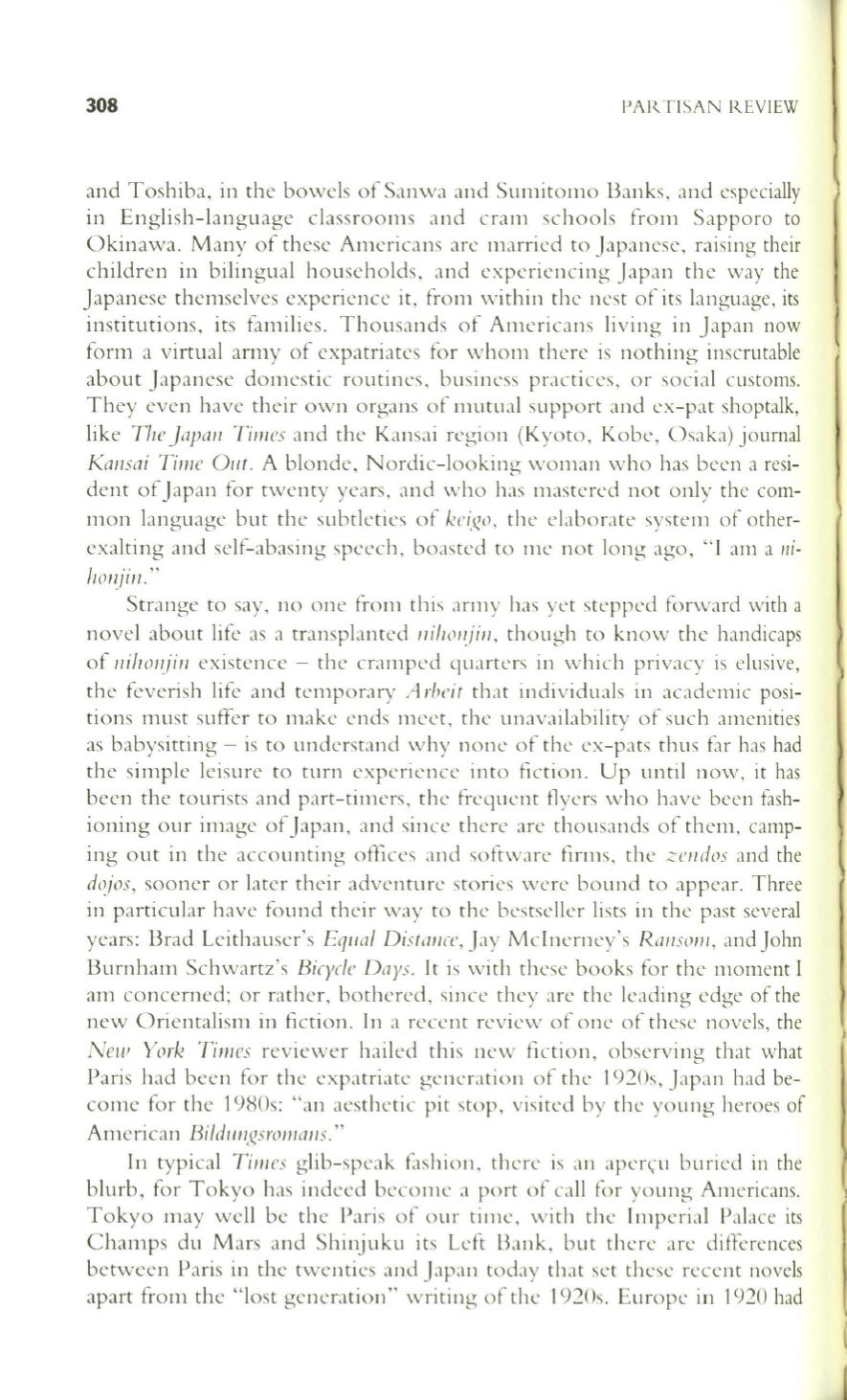
308
PARTISAN REVIEW
and Toshiba, in the bowels ofSanwa and Sumitomo 13anks, and especially
in English-language classrooms and cram schools from Sapporo
to
Okinawa. Many of these Americans arc married to japanese, raising their
children in bilingual households, and experiencing japan the way the
japanese themselves experience it, from within the nest of its language, its
institutions, its families. Thousands of Americans living in japan now
form a virtual army of expatriates for whom there is nothing inscrutable
about japanese domestic routines, business practices, or social customs.
They even have their own organs of mutual support and ex- pat shoptalk,
like
Tlie Japall Tillles
and the Kansai region (Kyoto, Kobe, Osaka) journal
Kallsai Tillie Ol/t.
A blonde, Nordic-looking woman who has been a resi–
dent of japan for twenty years, and who has mastered not only the com–
mon language but the subtleties of
k('~~(J,
the elaborate system of other–
exalting and self-abasing speech, boasted to nK not long ago, "I am a
11;–
liOI~jill.
"
Strange to say, no one from this :lrIl1y has yet stepped forward with a
novel about life as a transplanted
l1iliolljill,
though to know the handicaps
of
lIi"OI~jill
existence - the cramped quarters in which privacy is elusive,
the feverish life and temporary
A
r/Jcit
that individuals in JCademic posi–
tions must suffer to make ends meet, the unavailability of such amenities
as babysitting - is to understand why none of the ex-pats thus Gr has had
the simple leisure to turn experience into fiction. Up until now, it has
been the tourists and part-timers, the frequent flyers who have been fash–
ioning our image of japan, and since there arc thousands of them, camp–
ing out in the JCcounting offices and software firms, the
;:clldos
:lI1d the
d%s,
sooner or later their adventure stories were bound to appear. Three
in particular have found their way to the bestseller lists in the past several
years: Brad Leithauser's
Eql/al Distallce,
jay Mc inerney's
Rallsolll,
andJohn
Burnham Schwartz's
Bicyrlc Days.
It is with these books for the moment I
am concerned; or rather, bothered, since they arc the leading edge of the
new Oriental ism in fiction. In a recent review of one of these novels, the
NelV York Tillles
reviewer hailed this new fiction, observing that what
Paris had been for the expatriate generation of the 1920s, japan had be–
come for the 1980s: "an aesthetic pit stop, visited by the young heroes of
American
BiidI/IIJZsrolllalls."
In typical
Tilllcs
glib-speak fashion, there is an apen;-u buried in the
b lurb, for Tokyo has indeed become a port of call for young Americans.
Tokyo may well be the Paris of our time, with the Imperial Palace its
Champs du Mars and Shinjuku its Left Bank, but there arc differences
between Paris in the twenties and japan today that set these recent novels
apart from the "lost generation" writing of the 1920s. Europe in 1920 had


